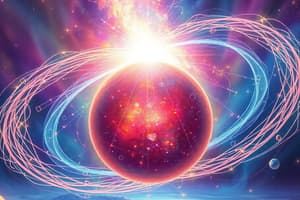Podcast
Questions and Answers
What is the smallest particle of an element that can exist and still be the same substance?
What is the smallest particle of an element that can exist and still be the same substance?
- Compound
- Atom (correct)
- Mixture
- Molecule
Freezing is the process where a solid changes to a liquid.
Freezing is the process where a solid changes to a liquid.
False (B)
At what temperature does water freeze into ice?
At what temperature does water freeze into ice?
0°C
The process of a liquid changing into a gas is called __________.
The process of a liquid changing into a gas is called __________.
Match the phase change with its corresponding description:
Match the phase change with its corresponding description:
What happens to the particles of a substance when it is heated?
What happens to the particles of a substance when it is heated?
The boiling point of water is 100°C.
The boiling point of water is 100°C.
During condensation, vapours lose __________ to change back into liquid.
During condensation, vapours lose __________ to change back into liquid.
What happens to gas when the temperature decreases?
What happens to gas when the temperature decreases?
Sublimation is the process where a solid changes directly into a gas.
Sublimation is the process where a solid changes directly into a gas.
What is produced when carbon dioxide reacts with limewater?
What is produced when carbon dioxide reacts with limewater?
A gas changing directly into a solid is called _____.
A gas changing directly into a solid is called _____.
Match the following gases with their tests:
Match the following gases with their tests:
What is the primary characteristic of a vacuum?
What is the primary characteristic of a vacuum?
Dry ice is an example of a substance that undergoes the process of deposition.
Dry ice is an example of a substance that undergoes the process of deposition.
What equipment do astronauts use to breathe in space?
What equipment do astronauts use to breathe in space?
Flashcards are hidden until you start studying
Study Notes
States of Matter
- Matter exists in three states: solids, liquids, and gases.
- Matter comprises tiny particles known as atoms, the smallest unit of a substance (element).
Particle Theory of Matter
- All matter is made up of particles that are constantly in motion.
- The motion and arrangement of these particles determine the properties of each state of matter.
Changing States of Matter
-
Melting:
- A cold substance absorbs energy when heated, overcoming attractive forces between particles.
- Increased temperature leads to solids melting; for example, ice melts at temperatures above 0°C.
-
Freezing:
- The process involves heat transfer from a hot substance to its surroundings.
- The decrease in temperature leads to close packing of particles, resulting in a solid form; water freezes into ice at 0°C.
-
Vaporization:
- Occurs when water boils, with bubbles forming as molecules gain enough energy to transition to gas.
- Water vaporizes at a boiling point of 100°C, changing from liquid to gaseous state.
-
Condensation:
- Involves vapor losing energy when in contact with cold surfaces, leading to a transition from gas to liquid.
- This process is the reverse of vaporization, forming droplets of liquid water.
-
Sublimation:
- Direct transition from solid to gas occurs when solids absorb energy sufficient to overcome intermolecular forces.
- A common example is dry ice transitioning directly to carbon dioxide gas.
-
Deposition:
- The reverse of sublimation; gas transitions directly to solid without passing through a liquid state.
Breathing in Space
- Space is a vacuum, lacking particles.
- Astronauts rely on oxygen supplies in backpacks, which circulate through spacesuits for breathing.
Tests for Gases
-
Unique tests identify gases in compounds, ensuring clear results.
-
Oxygen:
- Glowing splint relights when introduced to oxygen in a test tube, indicating its presence.
-
Hydrogen:
- A lighted splint produces a squeaky pop when near hydrogen, confirming its presence.
-
Carbon Dioxide:
- Bubbling carbon dioxide through limewater (calcium hydroxide solution) forms a white precipitate of calcium carbonate, turning the solution milky, indicating the presence of carbon dioxide.
Summary Table of Gas Tests
- Oxygen: Glowing splint relights → Oxygen is present.
- Hydrogen: Lighted splint pops → Hydrogen is present.
- Carbon Dioxide: Limewater turns milky → Carbon dioxide is present.
Studying That Suits You
Use AI to generate personalized quizzes and flashcards to suit your learning preferences.




